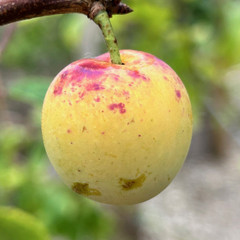Description
Excellent late cooking variety, first described in 1875 but probably much older. Very large handsome fruit, green with a deep rosy-red blush, which keep their shape when cooked. Superb, rich flavour, the fruit stores through until April. Widely grown in the North Riding of Yorkshire throughout the 1900s.
"The origin of Nancy Jackson is unrecorded, probably in Yorkshire pre-1875, and much cultivated in the North Riding in the 19th century. Taylor records that it was commercially grown in Sussex for the London market pre- 1945. Large, venerable and productive trees are still seen in old orchards around the North Riding. There, old trees are striking when seen from a distance, for although described (by Taylor) as a .. 'dull, drab, green-yellow apple with very dark red broad streaks', Nancy Jackson attains much greater depth and solidity of colour in the north. It is described in the Backhouse list as ... 'large, round and rather angular; bright crimson where exposed to the sun; firm, crisp and juicy with a brisk, acid flavour'. The RHS gold-award winning botanical artist Bridget Gillespie accurately describes her as '... a buxom wench, firm-fleshed, strong-shouldered and smooth-skinned'.
An excellent keeper, the crisp, juicy white flesh is sharply astringent at harvest, becoming more tender with a richer, more mellow flavour in store. It remains shapely on cooking, when the flesh takes on a lemon tint; this, in combination with the sharpness, makes it a perfect baker, especially cored and stuffed with almonds and dates. Good also for a French tarte, the contrast between red-skinned and yellow-skinned segments being most attractive." © Lin Hawthorne - 'The Northern Pomona'.
For help with choosing the correct rootstock for your needs, please click here A Guide to Rootstocks
For help with choosing the correct size and shape, please click here A Guide to Fruit Tree Shapes








